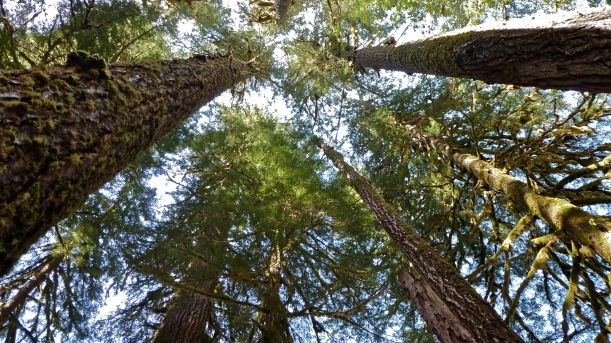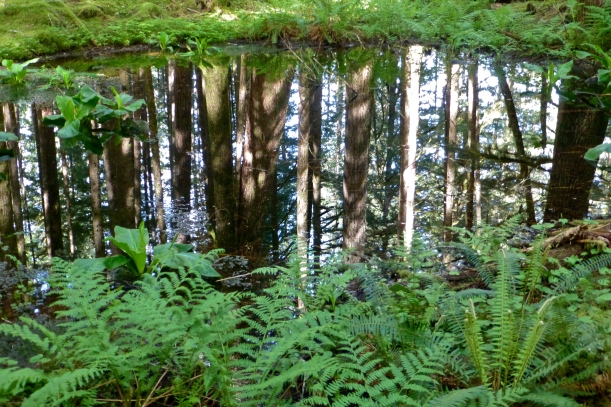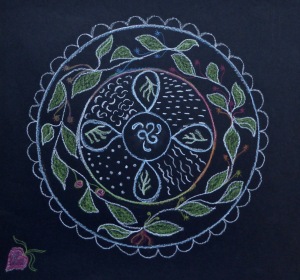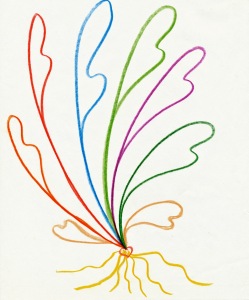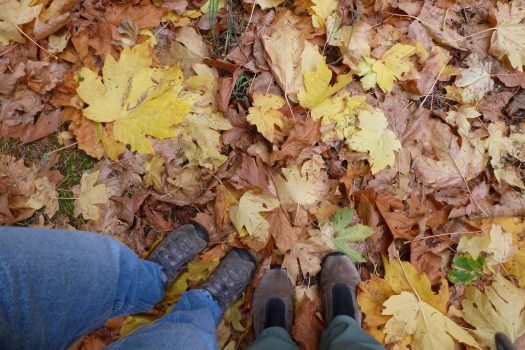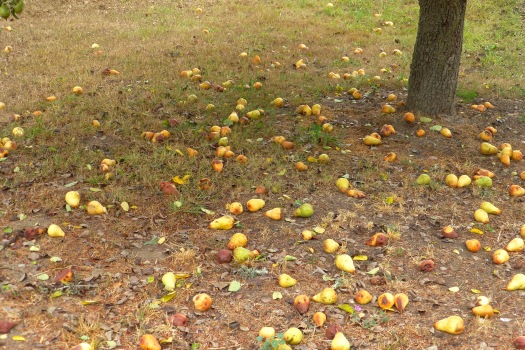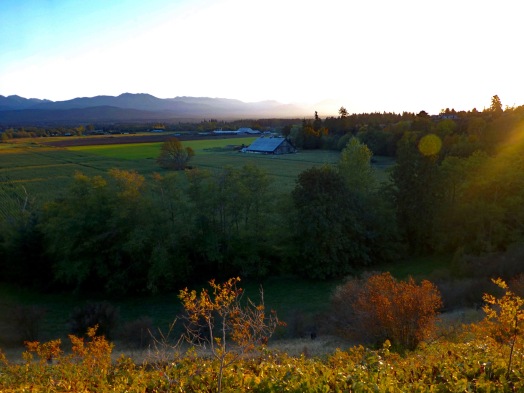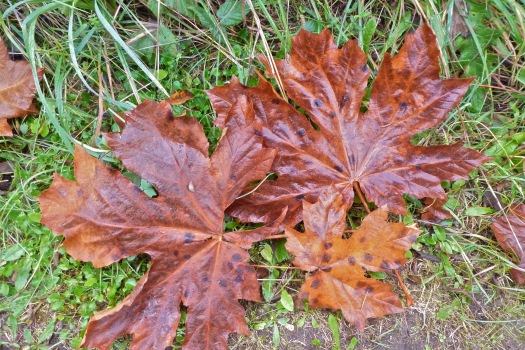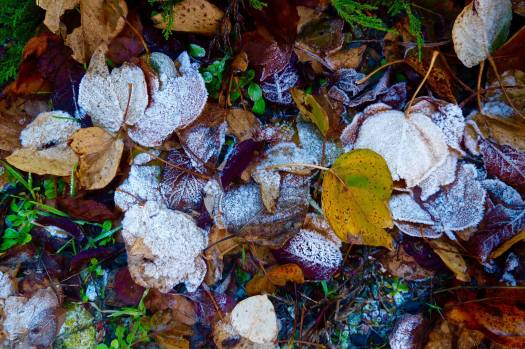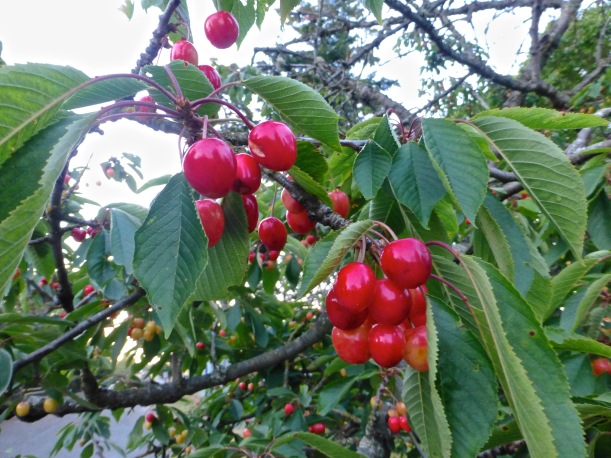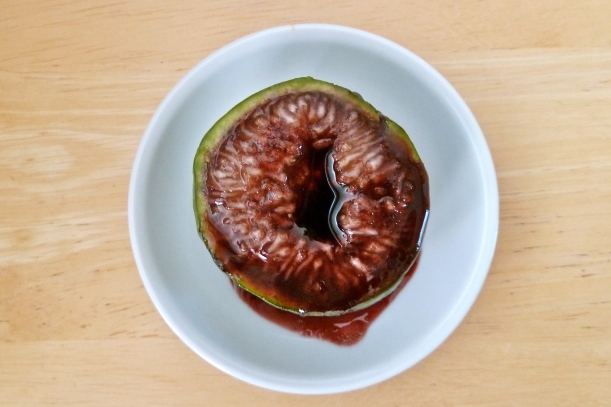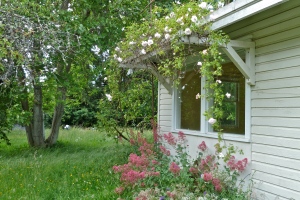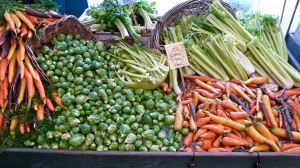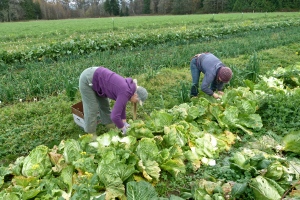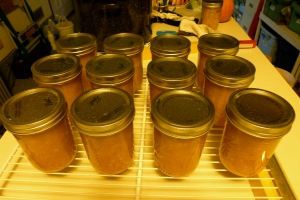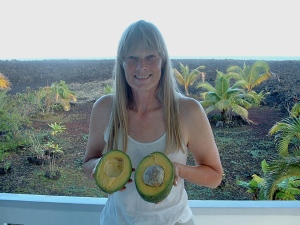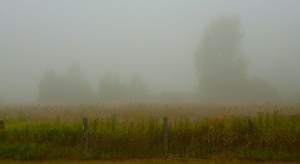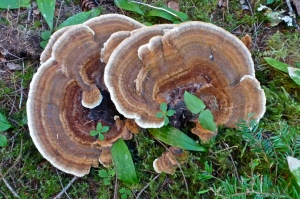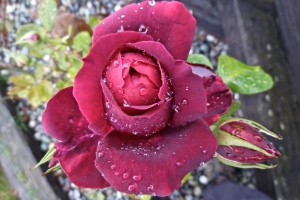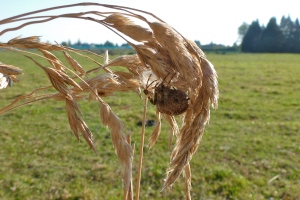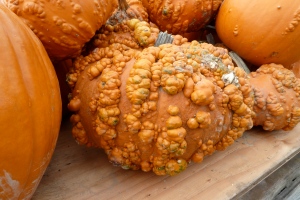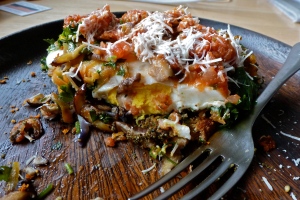Celebrating Imbolc on the Olympic Peninsula of Washington State in the Pacific Northwest.
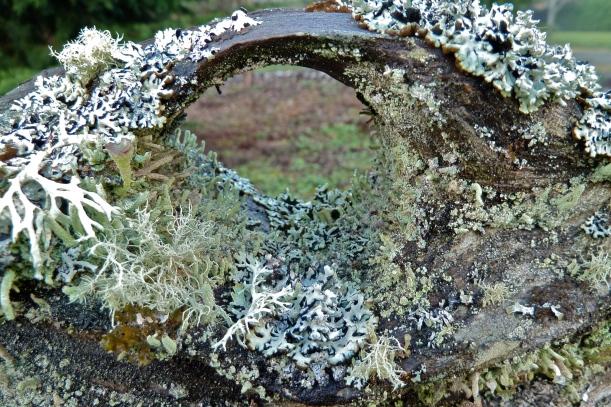
Rain-refreshed lichen-covered knothole in old cedar fencepost in our neighborhood.
“Signs of Imbolc Found in our Neighborhood”
The upwelling tides of Imbolc
wash over the landscape as
black-capped chickadees sing of rain
in blossoming quince shrubs,
daffodils spring open
blaring their golden trumpets,
Lenton roses host sleeping bumblebees
in the warmth of their green blossoms;
calves drop and rise wobbly, instinctively
seeking their mother’s nourishment,
soft and downy blossom clusters shoot up
from stiff and thorny blackberry canes,
profuse flowering masses of pink and white
spring heathers perfume the roadside,
and the great mystery of regeneration
expresses living wonderment to curious eyes.
“Poking Around the Yard for Imbolc Signs”
Out in the yard today poking around for more evidence of Imbolc energy and discovered several varieties of peppermints planted in containers including one from Bob Marley’s compound in Kingston, Jamaica, and another from an old homestead in the Dungeness River Crossing area were poking up into the sunshine. Also Italian flat-leafed parsley, chives, French tarragon, parsley, thyme, purple bee balm (Monarda fistulosa) and raspberry red bee balm (Monarda didyma) were pushing up through the soft ground plus the Common Field-speedwell (Veronica persica), chickweed, purple pansies, calendula, and a small red rose growing close to the house foundation were in blossom. The spiky rosemary bushes are flourishing and the lawn is bespeckled with English daisies.
“Imbolc Signs Found within the House”
Even in the house and cool storage areas of the store room, Imbolc energy and its subtle signs are hiding in the darker recesses waiting for the time of change. I notice them first, in of all places, my refrigerator crisper where beets and carrots from the garden’s harvest lie. Pale yellow leaves have sprouted on the veggies stored beside the recently-purchased vegetables and mushrooms destined for hearty soups and stews. The stored carrots and beets are responding, not to an impulse of light, but to the more ancient rhythms, one that can penetrate into a chilled metal box, surrounded by electrical currents.
In the cool spaces of the garage/storage area where I store potatoes, onions, garlic and a variety of winter squashes, I also note changes in form and texture. As I cut and dice, I notice pale green sprouts appearing inside at the base of the garlic and onions. Because we have a healthy harvest of alliums, indeed, many continue this natural sprouting process of the developing flower bud and eventually work their way up through the many leafy, outer layers. These bud sprouts historically find their way into a morning omelet as the first harvest greens of the season. This actually can occur earlier, surprisingly at the Yuletide season, depending on the warmth, and strength of the yearly impulse. Another sign of their growth is a gassing off, which if not noticed, have you looking all around for a source of the sour stink.
I remember one wintery day a number of years ago, I became aware of errant white tendrils of anemic alien creatures having escaped notice and making their way out of a brown paper sack stashed to the back of the storage area. Inside the small bag were untreated organic potatoes, their withered bodies now vestiges of their once plump selves. Fortunately, I tossed them in my worm bin and the activity and warmth kept them viable until such time as I could plant them outdoors. By then they had plumped up and upon planting, produced a healthy crop of spuds.
Even inside store-bought spaghetti squashes and winter squashes, the seeds may begin to sprout, helping to deteriorate the flesh upon which they are feasting. Like a spawning fish, these signs of passing along their body’s nutrients to future generations show up in the change of the outer skin, forming mold and rot which happen quickly if not inspected almost daily.
Clearly, once again, the Imbolic forces that stimulate growth in the northern hemisphere have taken charge.
“Imbolc Energies in the Natural World”
For me, Imbolc is a time of weaving the seasons together, an in-between time, poised to move forward into the warming, light-filled spring season or if necessary, languish in the dormancy of late winter. Our senses are also poised for a renewal of familiar and new smells, tastes, textures, sounds, and sights after the melancholic weariness of winter.
Bodies ready to break out of “cabin fever days” and catch “spring fever” cue on the sound of migratory fowl as perhaps one of the primary clues that a major transition is in the workings. Bird songs, whistles, cackling or the whispering of wings awaken inner prompts. Also the sensual clues of soft, furry pussy willows, of trickling springs and creeks lined with bright green mosses and ferns, warm sunshine break-throughs, fresh green fragrant shoots poking through where snow has melted away, the emergence and early harvesting of foraged plants like nettles and chickweed, these all carry the same potential message that winter is on the wane.
Plants that choose this time for ascendancy usually have adapted forms and coverings or mechanisms to survive frosts, snows, blizzards, ground heaving and yes, even sun. We think usually of tulips, jonquils, and nettles but my favorite plant of the season is a bog plant, with a weird odor. It initiates the season early, often in time for winter solstice. That plant is the skunk cabbage, aka the swamp lantern, swamp candle.
By some chemical wizardry, probably related to the calcium oxalate crystals it contains, the skunk cabbage (Lyschiton americanum) can melt its way through ice to become the earliest of sprouts on which bear and beaver feed. A thick, fleshy flower spike surrounded by a pale yellow spathe rises through last year’s dead growth and pond muck, adding a candle-like spot of brightness to the landscape of gray alders, wispy salmon berry canes, and dark green cedars. Inside this partly rolled flower covering are hundreds of minute flowers. Their exotic, skunky odor draws pollinating flies.
The large leaves (over three feet long and a foot wide) emerge later and along with ferns, miner’s lettuce, and nettles, will fill a swamp with their lush foliage. Although the smell and name of the plant may strike some as offensive, it describes a truly unique plant of our wet-woods habitat. Its flesh provides food for the hungry, its leaves provide shade and nutrients for the ecosystem, and its exotic nature attracts poets, photographers, and painters.
At some inner level of knowing, I feel our living earth actuates her seasonal dance dressed as the skunk cabbage. Stimulated by the energies of winter solstice or Imbolc, she spirals upward through the snow and ice-covered pond muck to begin her dance of creation and color, setting the scene for spring. As the days lengthen and the temperatures warm, her verdant robes unfurl to shade the bog and keep her root zone moist from the summer’s heat. She’ll dance until the autumn urges rest and the fall rains rot her gown, then; safely asleep in the muck of the pond, the swamp candle will slumber until the renewal energies of late winter stir her once again to awaken and rise, beckoning the Earth Mother to dance once again.
“Imbolc, The Inner Rhythm’s Journey”
The awareness of the seasonal shift into Imbolc represents an awareness of spiraling into the warming season of spring and that winter is on the wane, approximately midway between the winter solstice and spring equinox. In lands still locked in the slumber of winter, it is a time for farmers to check the number of healthy animals against their stored grains and grasses to see if there is enough to feed them until the animals can freely graze. Below ground animals in hibernation are becoming restless, baby bears are being born while mothers are in a lighter sleep mode. Seeds and bulbs are feeling the impulses to send down shoots, connect to mycelia and begin the feeding processes which will help them to soon shoot upward.
Historically it was and still is a time for householders to check the condition of stored vegetables and other food stuffs and make plans accordingly. It’s a time of cleaning up the clutter and messiness of winter debris.
In lands that have already thawed, it is physically marked by calves and sheep being born because there is apt to be enough fresh green grasses to feed the mothers so they have a plentiful milk supply. Wild foods become available to supplement our daily diets.
Historically Imbolc is represented by Brigid, the Celtic goddess of healing, poetry, mysticism, and smithcraft. Now, however, climate and social changes have made the development of healing and crafting arts very important once again. Developing the skills of carpentry, leather work, gardening, house-holding, energy work, and herbal medicine making are becoming popular as is using nature as a primary teacher for children. Homeschooling is commonplace. Writing, art, and poetry are defining us as populations and souls bound to Gaia from whom all blessings flow.
But even more than that, it’s a time when we can re-acquaint ourselves with inner rhythms and invest in new opportunities to develop them. The universal rhythms will support the change once acknowledged. So clean out the closet both outer and inner, then take inventory and organize what’s left. If dissatisfied with what you find, develop new ways to bring that interest, that passion into your life, even if only in small ways in order to keep the candle spark alive.
There is so much available to us during Imbolc: as above, so below, and dwelling within, all three gestures happening at once and ready for attunement once we take time to acknowledge a desire to develop a path of peace and beauty within our lives co-creatively with Gaia.
Curiosity,
sparks the imagination,
feeds the soul’s journey.
May Imbolc spark your creativity, curiosity and imagination. Blessings to one and all.


